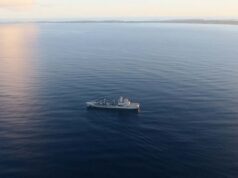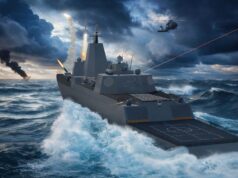The Dreadnought class will replace the Vanguard class submarines from 2028 onwards and will host the United Kingdom’s nuclear deterrent.
The United Kingdom’s nuclear deterrent today is hosted by the Vanguard Class submarine. The class has been purpose-built as a nuclear powered ballistic missile carrier, incorporating a selection of successful design features from other British submarines. Due to this it is quite unlike its predecessor, itself an adaptation of the Valiant class.
The Vanguards were designed and built by Vickers Shipbuilding and Engineering Limited at Barrow-in-Furness. They are by far the largest submarines ever manufactured in the United Kingdom and the third largest unit in the Royal Navy. A special manufacturing facility had to be purpose-built at Barrow for their construction.
The Vanguard Class submarines are larger than the Resolution Class they replaced mainly due to the need to accommodate the Trident D5 missile. However, the crew complement of a Vanguard Class boat is smaller – 132 officers and men compared to a Polaris submarine’s crew of 149. The newer boats include a number of improvements over previous British submarines, including a new design of nuclear propulsion system and a new tactical weapon system for self-defence purposes both before and after missile launch. The 16 tube missile compartment is based on the design of the 24 tube system used by the United States Navy’s Ohio Class Trident submarines.
In August 2003 it was ten years since the lead boat, HMS Vanguard had commissioned. In 2005 she returned to service after completing the first of the two Long Overhaul Periods (the first including a nuclear refuelling) planned during her service life. She was designed with a twenty-five year hull life and thus was expected to require replacement by about 2019, but a less demanding operational profile and deployment cycle than originally anticipated will allow her projected service life to be extended to 2024 if required, and it seems like it will be.
As things stand today, the Astute project currently seems likely to end with the completion and delivery of the seventh hunter-killer around 2019, while the first Vanguard replacement is required in 2021.
Government approved initial gate for the Dreadnought submarine programme to replace the the Vanguard class in May 2011.
While details remain sketchy at best regarding the Dreadnought class, one of the key features the new boats will have is a Common Missile Compartment (CMC). CMC aims to define the missile tubes and accompanying systems that would be used to launch new ballistic missiles, successors to the current Trident II/ D5 missile fleet used by the USA and Britain.
As key trends like cheaper sensors, increasing autonomy and artificial intelligence march onward, the next 40 years will see big changes in the underwater environment. SSBNs will need the flexibility to adapt to these changes if they intend to survive.
For the USA and Britain, the CMC needs to be part of that adaptation. Key options under consideration include a widened diameter for each tube from 2.21m – 3.04m, and the potential for flexibility beyond nuclear missiles, this would provide incredible future-proofing while delivery a (to some unwise), multirole capability.
The British government took the first steps in 2006 towards a joint US-UK missile compartment and the project was launched in 2008, initial gate approval for Britain’s ‘Successor’ project followed in 2011. Other contracts have followed, covering design and even the new kind of nuclear reactor the submarines are expected to use.
There is a precedent for this in the United States, the Virginia Class Block III fast attack submarine replaced their 12 vertical-launch cruise missile tubes with 2 Common Weapon Launcher (CWL). The size of those CWLs allows Virginia Class Block III submarines to launch cruise missiles, UAVs, UUVs, and more from their tubes.
British and American collaboration will also benefit and informs the Dreadnought class missile capability. The 2010 Strategic Defence and Security Review stated the submarine will have eight operational missiles, carrying no more than 40 operational warheads between them. Furthermore, an important feature of the collaboration between the UK and the US has been collaboration between the UK and the US on the new and advanced PWR-3 pressurised water reactor nuclear.
PWR-3, representing the third generation of British pressurised water reactors, builds on cutting edge nuclear propulsion research undertaken by the MoD and Rolls-Royce in the last few decades and is rumoured to be at a very advanced stage of development.
The exact nature of the UK’s industrial access to US reactor technology remains largely unknown in the public domain, the Royal Institution of Naval Architects reported previously that it is likely that the UK has been given a good look at the S9G reactor design that equips the US Navy’s Virginia Class submarines.
Back to the missile compartments, there is no question that the future Common Missile Compartment will be built around the nuclear deterrence mission as its primary focus. That is unlikely to be its sole use, however, and it would not be surprising if some of those other potential uses ended up influencing the CMC’s design. As is the case with a force more focused on multi role capability, versatility is key. Industry is unsurprisingly quiet on the specifics of the engineering and technology but industry has given some intriguing glimpses at what we may see in the water, one day.
According to BAE, the lead partner for the Dreadnought programme, work on the concept design phase had been ongoing since 2007, but this has now completed, and an outline submarine design has been selected.
Following the Government’s approval of the Initial Gate Business Case in May, 2011, the programme moved into the Assessment Phase, which is the first major stage of the new submarine’s design and development. This is where the vessel concept and requirements are fleshed out and finalised into a detailed hull form and systems.
First Sea Lord, Admiral Sir Mark Stanhope recently commented that
“The Royal Navy has been operating continuous at-sea deterrent patrols for more than 40 years, the Successor submarines will allow us to do so well into the future with cutting-edge equipment.”
The project will now move into the next stage, known as ‘Delivery Phase 1’, with manufacturing work beginning on structural steel work for the ‘auxiliary machine spaces’ of the first submarine: this contains switchboards and control panels for the reactor.
The money will also be spent furthering the design of the submarine, purchasing materials and long lead items, and investing in facilities at the BAE Systems yard in Barrow-in-Furness where the submarines will be built.
Tony Johns, Managing Director of BAE Systems Submarines said:
“This additional financial investment by the MOD is an expression of confidence in our ability to build these sophisticated vessels.
We have been designing the new class of submarine for more than five years and thanks to the maturity of our design, we’re now in a position to start production on the date we set back in 2011.
This is a terrific achievement and I pay tribute to all those who have made this possible.”
With regards to cost, it’s expected that the Dreadnought submarines and their infrastructure will cost around £15 billion. This can be broken down as such:
- £0.25 billion to participate in the Trident D5 missile life extension programme.
- £11 billion for a class of four new submarines.
- £2 billion for possible refurbishing of the warheads.
- £2–3 billion for infrastructure (spent over 30 years).
“Of course, the deterrent is not cheap – no major equipment programme is. But our current nuclear weapons capability costs on average around 5-6 per cent of the current defence budget.”
David Cameron, the Telegraph, 4 April 2013
According to a series of statements made in Parliament by ministers of the MoD, the annual operating costs of the Trident programme will indeed be around 5 to 6 per cent of the defence budget.
This means that the replacement submarines will have a running cost of around £2 billion per year.
Estimates of the long term costs of big capital spends are notoriously hard to predict and can often fall or rise drastically. The costs associated with the programme are comparable to the procurement costs of major weapons systems such as Typhoon or Lightning aircraft.
The programme already employs more than 2,600 people across MoD and industry, including 1,800 at BAE Systems.
Thousands more will be employed in the supply chain with an average of 7,800 people expected to be working on Dreadnought each year throughout the duration of the programme.
At peak, in the early 2020s, BAE Systems anticipates employing more than 5,000 people on the Dreadnought programme.













I fully support the UKs stance on nuclear weapons.
However the mind blowing costs mean that conventional forces are being depleted to pay for it.
If we as as a nation want a SSBN deterrent then we should have properly funded defence budget.
I suggest 3% of GDP as appropriate, this would be funded from other departments budgets.
Which departments would you like to see cut? Education and the NHS are both underfunded – or perhaps chronically inefficient in the case of the NHS. Police, fire services have both been ravaged. That really leaves welfare and pensions as the two biggest pots. I cannot see any politician arguing to cut these depts in order to fund defence. If you are referring to foreign aid then even if we cut that it will go to other depts first.
The best hope for our defence budget is pressure from our allies to up our game. It would probably mean borrowing more rather than moving funds from elsewhere.
DFID and DWP are the main candidates, along with far simpler tax system and ensuring those who should be paying tax actually do so.
I also wish to see a reduction in welfare payments so claiming benefits is not a life style choice but a safety net.
Its not that I don’t agree with you, its just that I cannot see politicians making those choices. Increasing taxes can stump growth but yes those who illegally avoid tax should be made to pay, albeit that HMRC’s budget will need to grow to enable it.
Add £5bn a year to borrowing for the next 5 years to pay for much of the new equipment and go from there I would say. Headline debt to GDP is high but when you consider that £400+ bn of that is owed by the Government to the BofE then true borrowing is a lot lower. After all, is the Government going to raise £400bn to pay itself? No.
According to the guardian, the UK tax code document consists of 17000 pages of rules and regulation. It has trebled in size since 1997. The Hong Kong tax rules and regulations is just 276 pages, HK is recognised as having most efficient tax collection in the world.
Our tax system is overcomplicated and allows too many, both individuals and corporates, to avoid paying tax.
Regards QE it is a complicated experiment. Pumping huge amounts of cash into the economy and then holding it as sovereign debt has risks. Time will tell if it was the right thing to do.
We need politicians who reject the current mindset and are prepared to consider alternatives.
The still needs to do more to cut tax avoidance of the 1%ers. The inheritance paid by the Duke of Westminster was a joke.
Even if they paid the 35% that is expected of the rest of us, would go a long way to help.
The other area that needs snipped is final salary public sector pensions, they are completely unaffordable and should have been closed in the 90’s and replaced with average earnings which is still extremely generous.
This is the problem we are facing in the UK.
About 40% of our GDP goes towards maintaining our public services yet there are perpetual cries from all stakeholders that this is not enough. We have one of the most progressive taxation regimes in W. Europe and increasingly large proportions of our income coming from a small number of individuals, which I consider both unsustainable and worryingly un-resilient.
If we increase taxation we are likely to start suffering reduced growth as personal spending declines, which for our consumption based economy would be devastating. If only a few super wealthy individuals leave we couldn’t afford our spending.
In my opinion we are paralysed by political partisanship and have no single, uniting or reasoned vision around which we can rally. In short, we have neither the finances to implement the defence spending we need and we don’t have the political consensus required to effect change.
Moreover, the left has lurched towards extremism, supported by the mantra of “evil Torie cuts” by a compliant media. As such the government has been unable to make the decisions needed to reform the state as the political cost is too high – which is why Mrs. May just “lost” the last election. Meanwhile the population thinks money abounds and seem to have forgotten just how precarious our debt position is. As such we are threatened by a left wing take over of the economy which would make Brexit look like a brief rain storm during a picnic.
The British people have developed a corrosive sense of self-entitlement and a delusional, utopian reasoning. I don’t see a good future for our country given our circumstances – there are tricky times ahead.
Nathan I agree with much of what you say but our PM lost the election because she is useless. The general public are way ahead of our so called leaders. Statements such as Brexit means Brexit is not a policy to win an election as the public had already decided we were leaving the EU. She somehow managed to miss an open goal from a yard out in the worst election campaign since 1983
I don’t know or care what to cut but something has to be. The defence budget is only 2% of GDP. That leaves 98% of GDP for everything else. I would suggest that if any further reductions in spending are required they can come from the 98% not the 2%.
Rolls Royce are leveraging their investment in naval reactors for their SMR designs. http://www.telegraph.co.uk/business/2017/10/22/designs-mini-nuclear-power-plants-proposed-rolls-royce-led-group/
Good. That would be joined up thinking. Shame Govt doesn’t do same and make SMR’s a fundamental plank of UK’s carbon free energy independence strategy.
There is a competition running to promote just this – I think they realise that SMRs have the opportunity to solve our power crisis and to catapult us back in to the nuclear premier league. We shall see what comes of it.
Theresa May and BEIS have stalled responses to competition.
Should have been a huge Brexit hedge and core infra power to move to all electric transport system.
No longer relying on dodgy ME governments for oil and gas would be a huge geo-political bonus.
But then expecting anything bold or joined up from the current shower is well, like expecting anything better from the other shower…
#Depressing
I think £2bn pa to purchase,maintain and operate a nuclear deterrent is very good value for money and should come out of our defence budget.
I think the defence budget would be more efficient if it was 2.5% of GDP but think a radical overall of the organisation is needed a single force created.
A budget of £45bn is more than adequate for the following
Naval Force – £10bn
Land Force – £13bn
Air Force – £10b
Combat Support Group – £4bn (Medics, Engineers, Signals etc)
Core Logistics – £2bn (Movement and supplies)
CnC – £6bn. (Command, comms, Intel, SFG, Cyber, procurement, policy etc)
Each force budget should have 4 pots (Personnel & Welfare, Equipment purchase, Infrastructure & Support and Operations)
It may be simplistic – but it does work and this kind of rigour and back to basics approach seems to be missing in the MOD
The nuclear deterrent was placed in the defence budget by George Osborne when previously it had always been a separate item it should be removed again from the defence budget thus releasing the funds.
agree with you RH
The problem is not really which budget an item is included in. It’s whether there’s enough in he pot. With one or two exceptions I think we all know that defence needs more support or it starts, God forgive,to go the way of the German armed forces.
How many times, though, have we seen governments react to a crisis or panic into throwing money at some politically expedient nonsense to save face?
If a government can find a billion pounds at the drop of a hat if it has to then it can find another billion for defence. An extra billion a year over and above what has been already promised would go a long way to solving many of the issues we all talk about.
At the risk of agreeing with TH for a moment, if he can lobby his MP so can the rest of us!!!
Nuclear deterrent should be a nationally funded seperate budget. Not funded from central defence budget. If from defence budget then the budget has to be uplifted to fund the deterrent and not effect other conventional defence resources.
Another example of Osbourne and Cameron being inept, rubbish, shit and causing long term damage to the country. I think in the fullness of time Cameron will be seen as one of the worst PMs we have ever had.
Unfortunately we have had four terrible PMs in a row ; Blair, Brown, Cameron and now May. All prepared to go to war on the cheap. They seem to love grandstanding on the world stage but none willing to pay the bill. The wars have been disastrous costing us a fortune with the sad loss of many. The legacy is a loss of confidence in our politicians, a very weak military and a weakened country.
With the exception of Maggie T we haven’t had a good ‘un since Churchill as far as defence is concerned.
I have asked this before but got no answers. I am not a military man. Could the Vanguard class be repurposed to SSN capabilities? This would increase our SSN force and supplement the Astute’s, possibly without exorbitant outlay. My understanding is that the Vanguard’s are still World class hulls with 16 tube capabilities. Launching conventional weapons from them should not be a huge strain on the hull. Please, feel free to slap me down – as I said, I’m not military, but these are our first class systems, built to high standards, and probably capable of lighter duties even after 20 years.
The maintenance costs and refuel/reactor change would just make keeping an aging hull unsustainable. We do not have the submariners to crew more subs either, as working on these complex ships requires far more training than that of a surface vessel crewman
World class hull,what does that mean?